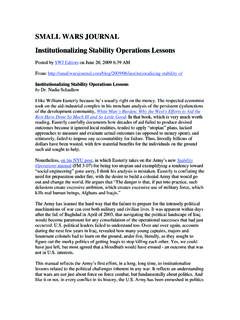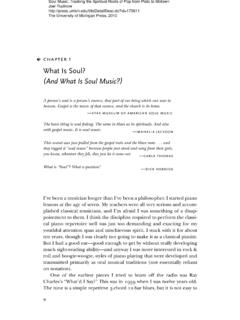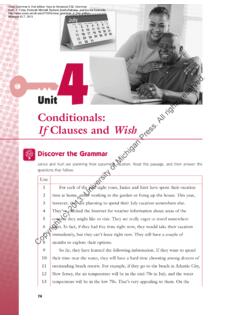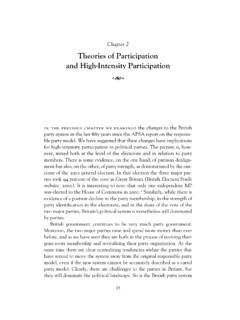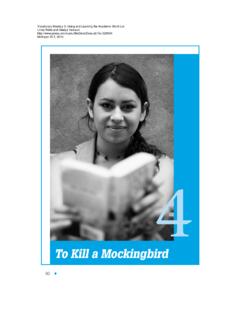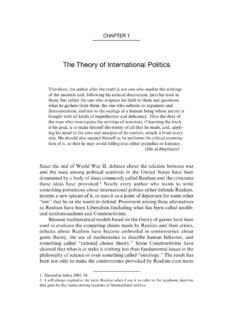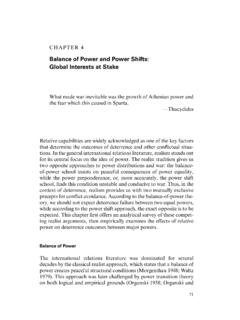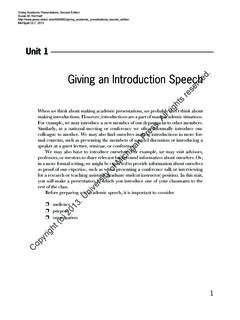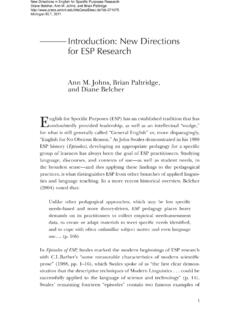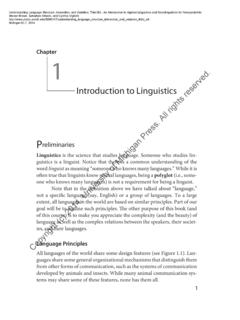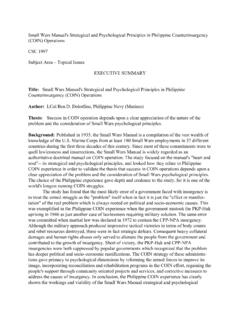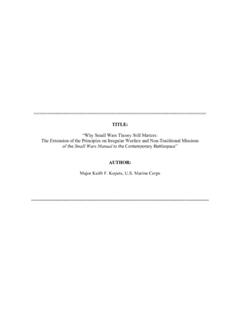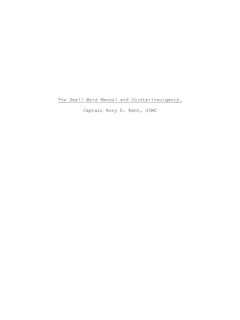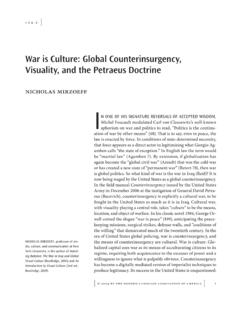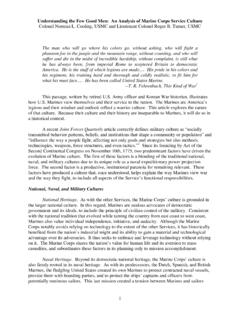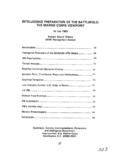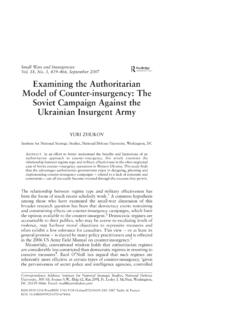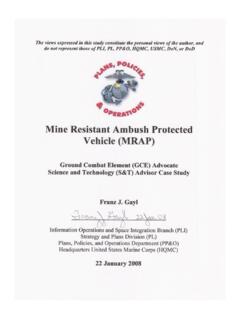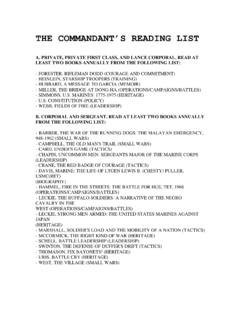Transcription of Military Learning and Competing Theories of Change
1 Chapter 1 Military Learning and CompetingTheories of ChangeTo Carl von Clausewitz, the father of modern militarythought, Military Learning and Military Change were a simple matter: If,in warfare, a certain means turns out to be highly effective, it will be usedagain; it will be copied by others and become fashionable; and so,backed by experience, it passes into general use and is included in the-ory. 1In other words, if something works, militaries will Change theirdoctrine and their practice accordingly. Although Clausewitz provideslittle explanation as to how this Learning on the battle eld becomes or-ganizational practice or why some armies learn while others do not, heclaims that armies have at least three opportunities to learn historicalexamples (of self and others), personal battle eld experience, and theexperience of other the case of the challenges facing the Military today, the mili-tary has had the opportunity to learn in all three of the ways suggested byClausewitz.
2 Starting with frontier duty in the early 19th century and con-tinuing to Iraq and Afghanistan today, the Military has built schools,run local governments, monitored elections, and provided general lawand order for war-torn societies both at home and abroad throughout itshistory. As chapter 2 describes, long before the peace operations of the1990s or the Phase IV and counterinsurgency operations in Iraq andAfghanistan today, soldiers and marines performed myriad S & Rtasks in the American South, the Philippines, the Caribbean, Europe,Japan, and addition to this historical and recent experience, the military91. Carl von Clausewitz, On War,ed. Michael Howard and Peter Paret (Princeton:Princeton University Press, 1984).
3 Lifting the Fog of Peace: How Americans Learned to Fight Modern War Janine Davidson The University of Michigan Press, 2010 has a tradition of studying other militaries around the globe,demonstrating that the Military is adept at Learning from the expe-rience of others. For example, the small wars Manualwritten by the Ma-rine Corps in the 1930s re ects the lessons of the British from their19th-century colonial wars as well as the Marine Corps own experiencein the Caribbean in the rst decades of the 20th , boththe Army and the Marine Corps consult the British and other allies inpreparing for urban operations, counterinsurgency, and this tradition, combined with their own long history of perform-ing Military operations other than war (MOOTW), Clausewitz wouldpredict that the Army and the Marine Corps would be quiteadept at performing them by now.
4 Moreover, their techniques would dif-fer little from each other or from those of their allies whose doctrinethey had contrast to Clausewitz, modern Theories of Military Change suggestthat militaries will have a dif cult time innovating at all. A primary de-bate among scholars of Military Change is over the catalyst for innova-tion. Do militaries Change on their own or in response to perceivedthreats, new technologies, or changes in the global system; or is some ex-ternal stimuli required to force the organization and its leaders to seethe light and adapt? If militaries are resistant to Change , what does ittake to in uence their behavior from the outside?
5 Under what condi-tions might efforts to force the Military to innovate succeed or fail? If, onthe other hand, militaries do Change on their own, what (or who)in uences the choices they make? Finally, whether the catalyst is internalor external, what explains the failure of militaries to Change whenneeded?In this literature, many posit that for various reasons, militaries needexternal actors to force innovation or Change . The critical point ofagreement among these scholars is that if left alone, the Military wouldbe unlikely to Change or would otherwise tend toward of Military innovation draw on three overlapping cat-10 lifting the fog of peace2. Keith B.
6 Bickel, Mars Learning : The Marine Corps Development of small wars Doctrine,1915 1940(Boulder: Westview Press, 2001); Colonel C. E. Callwell, small wars : Their Prin-ciples and Practice,3rd ed. (London: E. P. Publishing, 1976) (the rst edition of small Warswas published in 1896).3. Multiple interviews with 101st soldiers, 1st Marines, 2nd Marines, Marine CorpsWar ghting Lab, Army Peacekeeping and Stability Operations Institute, and the ArmyCenter for Lessons Learned Barry R. Posen, The Sources of Military Doctrine: France, Britain, and Germany between theWorld wars (Ithaca: Cornell University Press, 1984); Jack L. Snyder, Ideology of the Offensive: Military Decision-Making and the Disasters of 1914(Ithaca: Cornell University Press, 1984).
7 Lifting the Fog of Peace: How Americans Learned to Fight Modern War Janine Davidson The University of Michigan Press, 2010 of theory to explain why militaries often fail to adapt: organiza-tional theory, bureaucratic politics, and organizational eachof these schools, there exist factors that make them either averse tochange in general or inclined toward offensively oriented doctrine , each leads to different conclusions about howbarriers to innovation might be TheoryOrganization theory sees Military organizations as highly resistant organizational theorists, militaries resist innovation as a re-sult of structural systems, norms, and standard operating proceduresthat together focus behavior toward particular outcomes.
8 Graham Alli-son describes organizational behavior in this school less as deliberatechoices and more as outputs of large organizations functioning accord-ing to standard patterns of behavior. Moreover, organizational cultureemerges from these routines that reinforce norms, and the result be-comes a distinctive entity with its own identity and momentum. 8In thismodel, even when various actors within a Military organization desire achange in strategy or doctrine, such structural mechanisms would likelymitigate against it. Thus, in order for such Change to occur, the actualstructures and processes that produce strategy and doctrine must today s Military , many would point to the Pentagon s planning,programming, budgeting, and execution (PPBE) cycle as a key exampleof this phenomenon.
9 In this complex process, the four services ideallysubmit budgets based on the leadership s strategic priorities as outlinedMilitary Learning and Competing Theories of Change 115. Graham Allison, Essence of Decision: Explaining the Cuban Missile Crisis,2nd ed. (NewYork: Longman, 1999); Morton Halperin, Bureaucratic Politics and Foreign Policy(Washing-ton, DC: Brookings Institution, 1974).6. Carl H. Builder, The Masks of War: American Military Styles in Strategy and Analysis,Rand Corporation Research Study (London: Johns Hopkins University Press, 1989); Eliza-beth Kier, Imagining War: French and British Military Doctrine between the wars (Princeton:Princeton University Press, 1997); Stephen Peter Rosen, Winning the Next War: Innovationand the Modern Military (Ithaca: Cornell University Press, 1991); Steven Van Evera, TheCult of the Offensive and the Origins of the First World War, International Security9, no.
10 1(1984).7. Allison, Essence of Decision;Deborah D. Avant, The Institutional Sources of MilitaryDoctrine: Hegemons in Peripheral wars , International Studies Quarterly37 (1993); JamesMarch and Johan Olsen, The New Institutionalism: Organizational Factors in PoliticalLife, American Journal of Political Science78, no. 3 (1984); Halperin, Bureaucratic Politics andForeign Policy; Snyder, Ideology of the Allison, Essence of the Fog of Peace: How Americans Learned to Fight Modern War Janine Davidson The University of Michigan Press, 2010 the National Defense Strategy or the Quadrennial Defense Review,which should in turn re ect the immediate and projected needs of thewar ghters, as articulated somehow by the combatant commandersaround the world.
